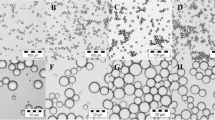Summary and conclusion
Due to the high interfacial tension between water and natural fats it is almost impossible to produce stable emulsions of these substances by mechanical means. It was found that the addition of emulsifying agents which lower surface tension, make possible the formation of stable emulsions. These emulsifying agents were found to be toxic and hemolytic in direct proportion to their surface tension lowering power. Surface active substances render the capillaries more permeable as demonstrated with T-1824 and account for the occurrence of pulmonary edema and death from shock after intravenous administration.
The droplet size is the limiting factor in emulsion stability both in vitro and in vivo. Electrolytes and globulins tend to break most emulsions while albumin tends to stabilize them. Different emulsions break at varying rates when mixed with serum.
Theoretical considerations and the above work show that, the preparation of fine emulsions by chemical means without emulsifying agents, and the use of water soluble dicarboxylic fatty acids compounds (or other synthetic fatty acids free of surface active properties), are worthy of future investigation.
Similar content being viewed by others
References
Skinsnes, O.K., Gelatin Nephrosis, Renal Tissue changes in Man from the Intravenous Administration of Gelatin. Surg. Gyne. & Obst., 85:563, 1947.
Nomura, T. Experimentelle Studien Über Intravenose Fettinfusion Unter Besonderer Berücksichtigung Parenteraler Ernährung. II Mitteilung Blut B′T′L′D′ und Blutdruckschwankung nach Fettinfusion. Tohoku J. Exp. Med., 12:497, 1929.
Holt, L.E. Tidwell, G.C., McNair Scott, T.F. Intravenous Administration of fat. Jour. Pediat., 6:151, 1935.
Narat, J. K. Observations on Parenteral Administration of fat Emulsions. Am. Jour. Digest. Dis. & Nitrit. 4:107, 1937.
McKibbin, J.M., Pope, A., Thayer, S., Ferry, R.M., Jr., Stare, F.J. Parenteral Nutrition. 1: Studies on Fat Emulsions for Intravenous Alimentation. Jour. Lab. & Clin. Med., 30:488, 1945.
Dunham L.J., Brunschwig, A. Intravenous Administration of Fat for Nutritional Purposes Experimental Study. Arch. Surg., 48:395, 1944.
Collins, H.S., Kraft, L.M., Kinney, T.D., Davidson, C.S., Young, J. and Stare, F.J. Parenteral Nutrition III Studies on the Tolerance of dogs to Intravenous Administration of fat Emulsions. I. Lab. T. Clin. Med. 33: 143, 1948.
Evelyn, K.A. Malloy, H.T. Micromethod for Determination of Hemoglobin, Methemoglobin and Sulfhemoglobin in a Single Sample of Blood. Jour. Biol. Chem., 126:655, 1938.
Rawson, R.E. The Binding of T-1824 and Structurally Related Diazo Dyes by the Plasma Proteins. Amer. Jour. Physiol. 138:708, 1943.
Ashby, G.K., The Effect of Lecithin Administered Intravenously. Proc. Soc. Exp. Biol. & Med. 61:13, 1946.
Hober, R. Permeability of Red Blood Corpuscles to Organic Anions. J. Cell. & Comp. Physiol., 7:367, 1936.
Hober, R., Andersch, M., Hober, J., Nebel, B. The Influence of Organic Electrolytes and non Electrolytes upon the Membrane Potentials of Muscle and Nerve. J. Cell. & Comp. Physiol. 13:195, 1939.
Hanger, F. M., Serological Differentiation of Obstructive from Hepatogenous Jaundice by Flocculation of Cephalin-Cholesterol Emulsions. J. Clin. Invest., 18:261, 1939.
Geyer, R. P., Mann. G.V., Young, J., Kinney, T.D., Stare, E.J. Parenteral Nutrition V. Studies on Soybean, Phosphatides as Emulsifiers for Intravenous Fat Emulsion. J. Lab. & Clin. Med. 33:163, 1948.
Hober, R. Physical Chemistry of Cells and Tissues. Blaikiston Co. 1945, page 274.
Loewy, A.L., Freeman, Willard L., Marchello, A., Johnson, V. Increased Erythrocyte Destruction on a high Fat Diet. Am. Jour. Physiol. 138:230, 1943.
Freeman, Willard L., Johnson, V. the Hemolytic Action of Chyle. Am. Jour. Physiol. 130:723, 1940.
Levene, P.A., Rolf, I.P. Synthetic Lecithins. J. Biol. Chem. 60:677, 1924.
Karrer, P., Solomon, H. Über die Glycerin Phosphorsauren aus Lecithis, Helv. Chim. Acta., 9:3–16, 1926.
Kabashima, I., Suzuki, B., Studies on the Synthesis of Lecithins and Cephalins Part I. The Synthesis of Dipalmityl—B—Cephalin and —B Lecithin. Proc. Imp. Acad. (Tokyo) 8:492, 1932.
McKibbin, J.M., Ferry, J.M., Jr., Stare, F.J. Parenteral Nutrition II. The Utilization of Emulsified Fat given Intravenously. J. Clin. Invest. 25:679, 1946.
Author information
Authors and Affiliations
Rights and permissions
About this article
Cite this article
LeVeen, H.H., Papps, G. & Restuccia, M. Problems in the intravenous administration of synthetic and natural fats for nutritional purposes. Amer. Jour. Dig. Dis. 17, 20–24 (1950). https://doi.org/10.1007/BF03002501
Received:
Issue Date:
DOI: https://doi.org/10.1007/BF03002501



